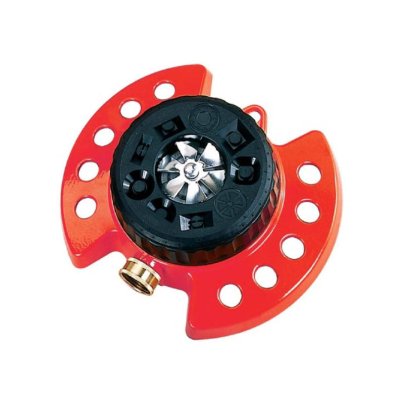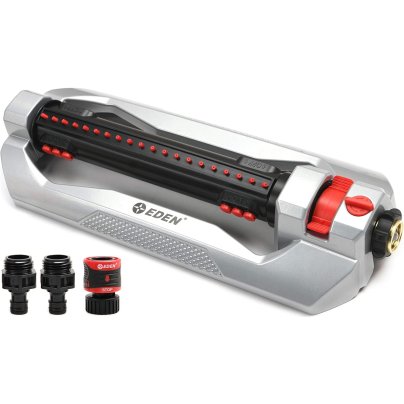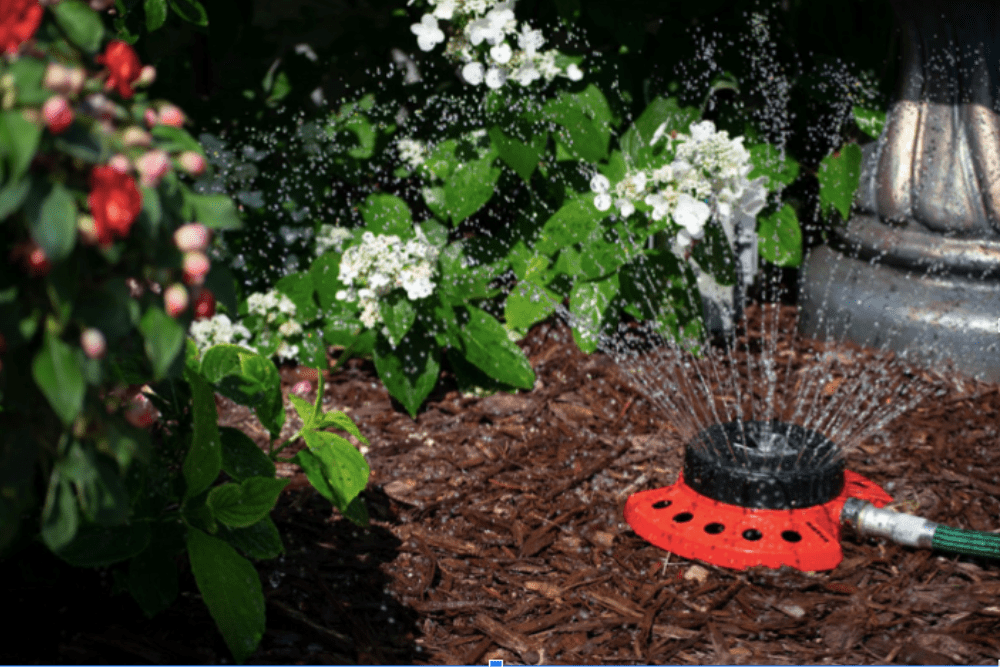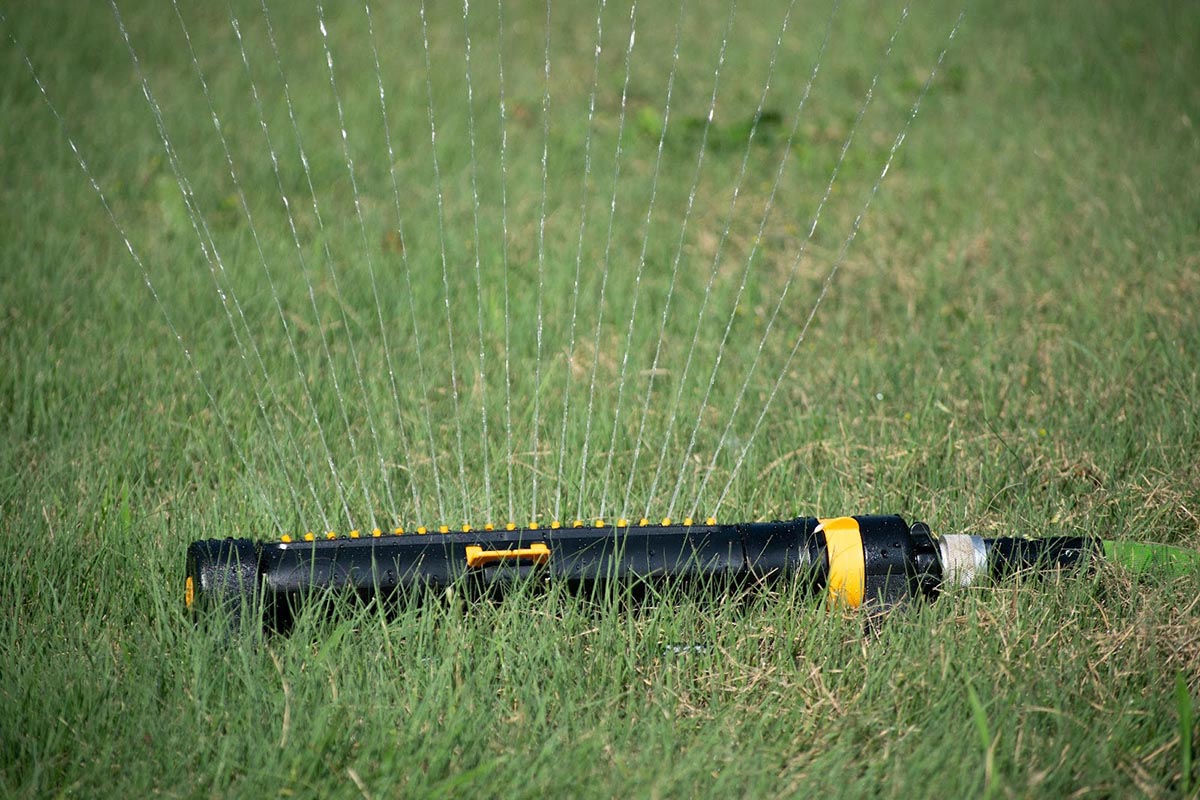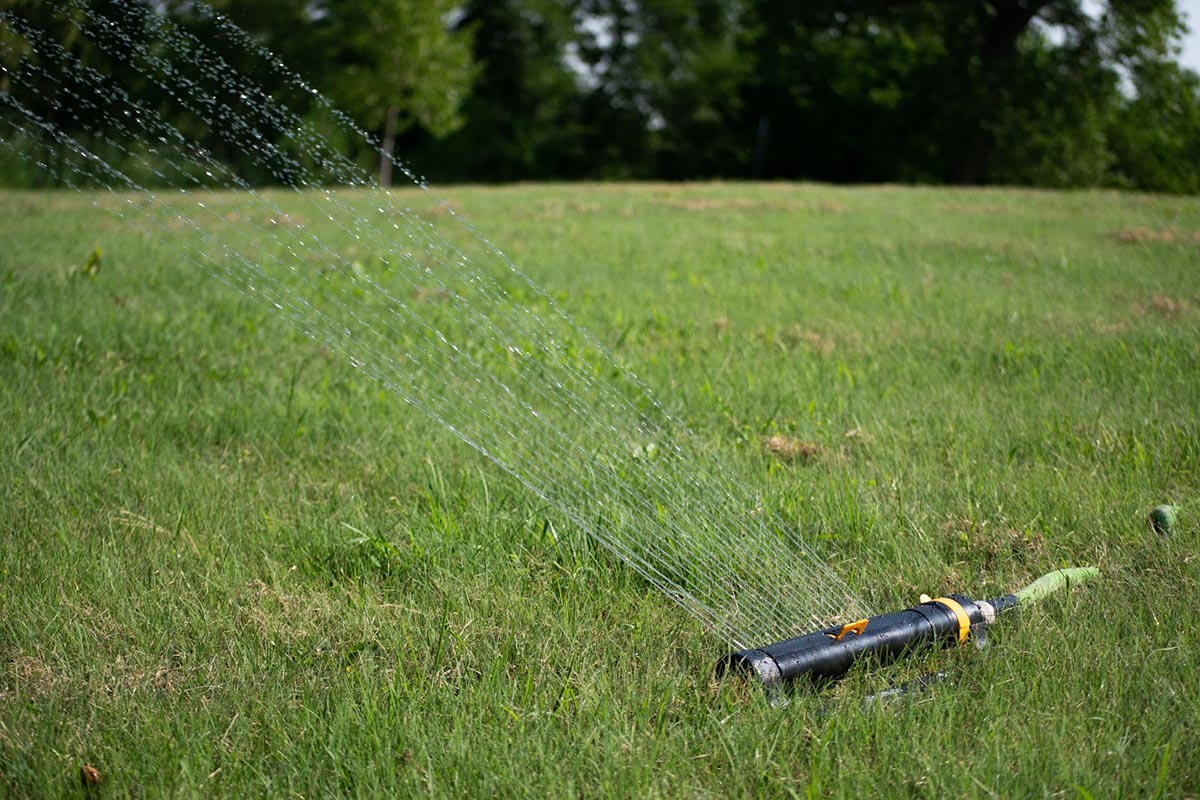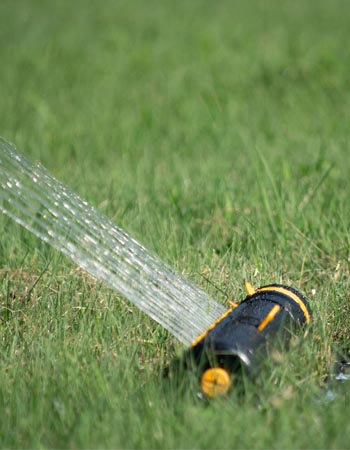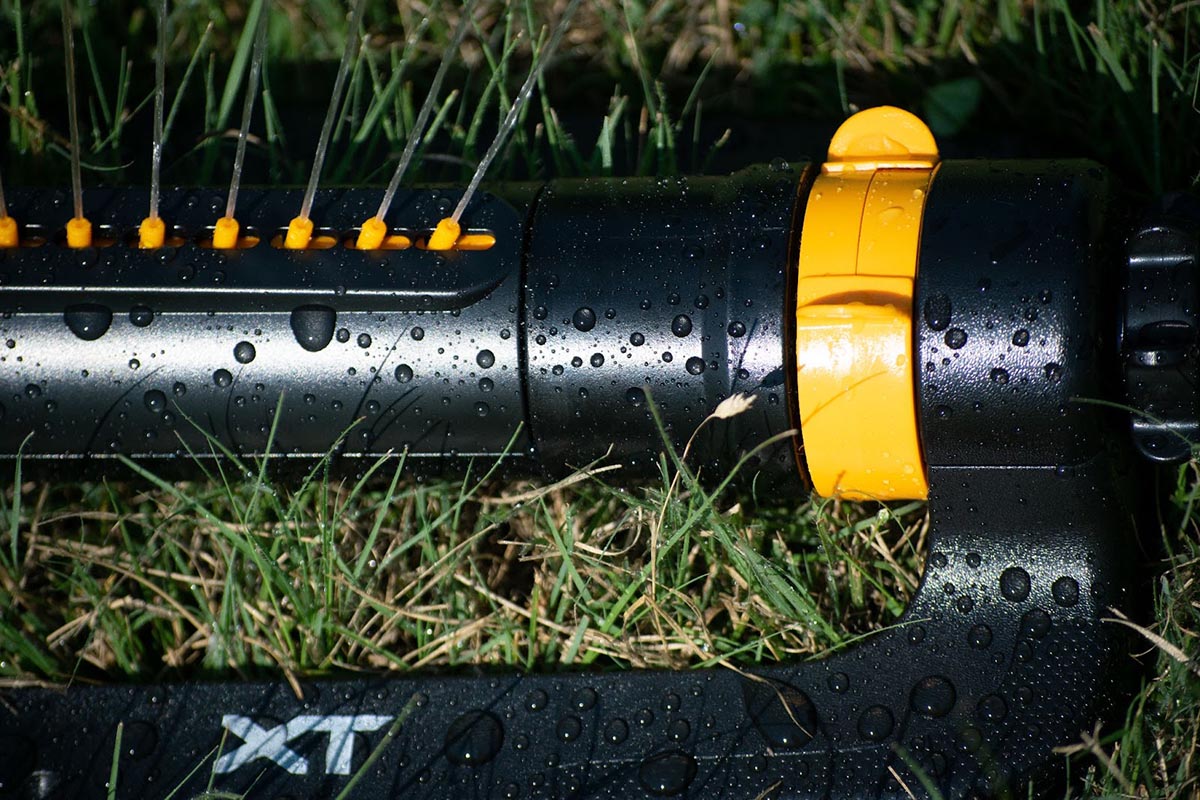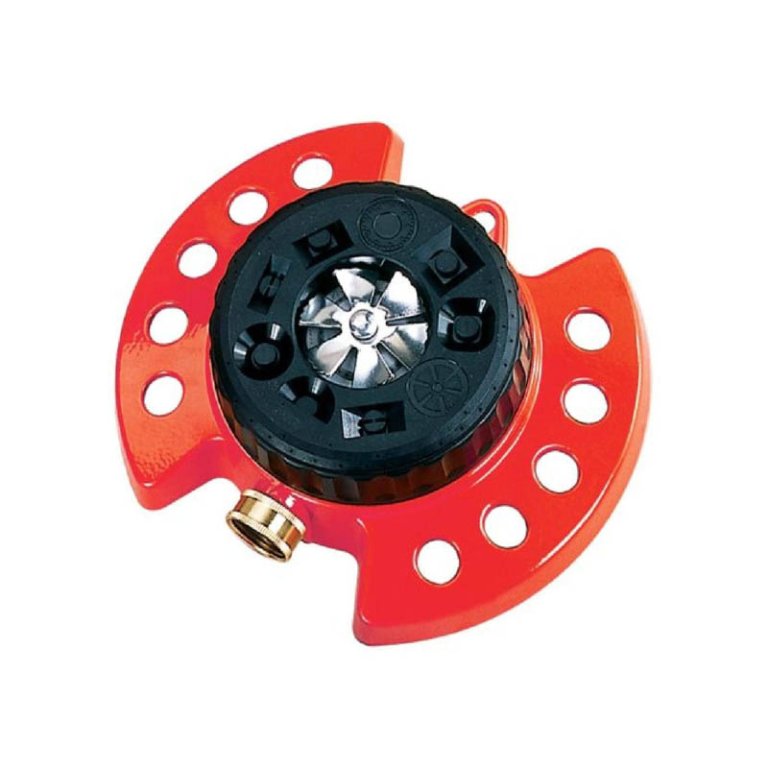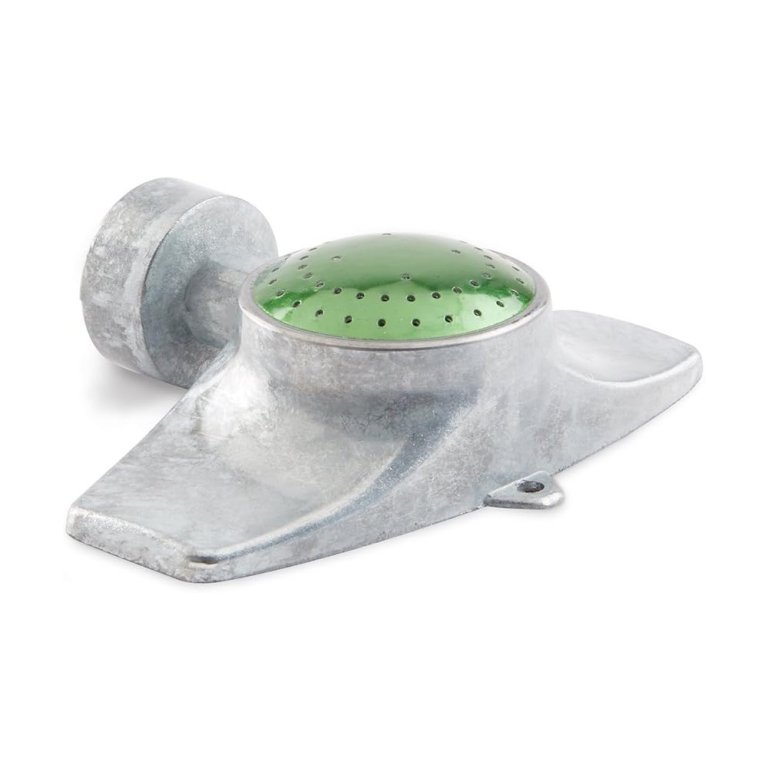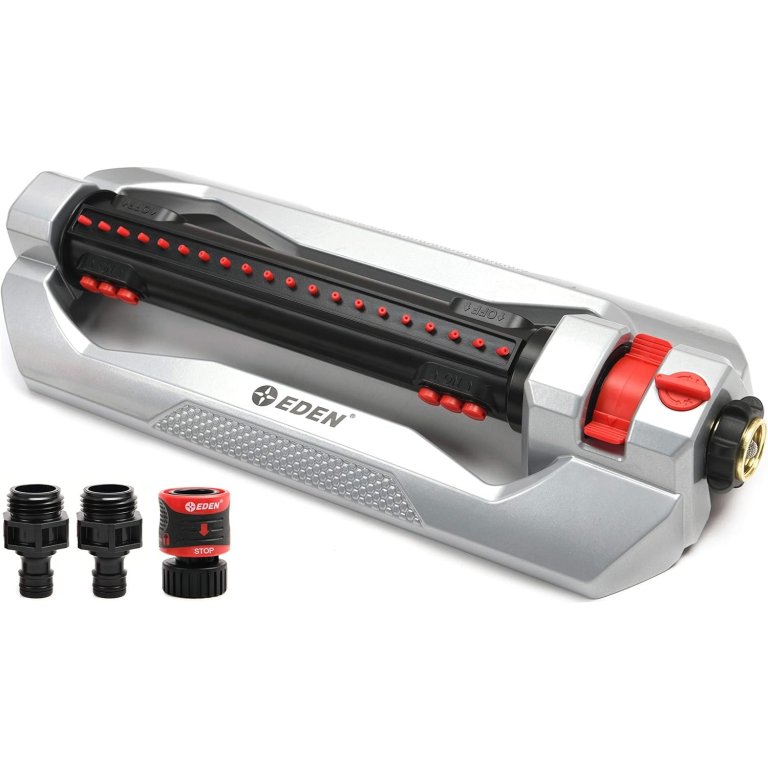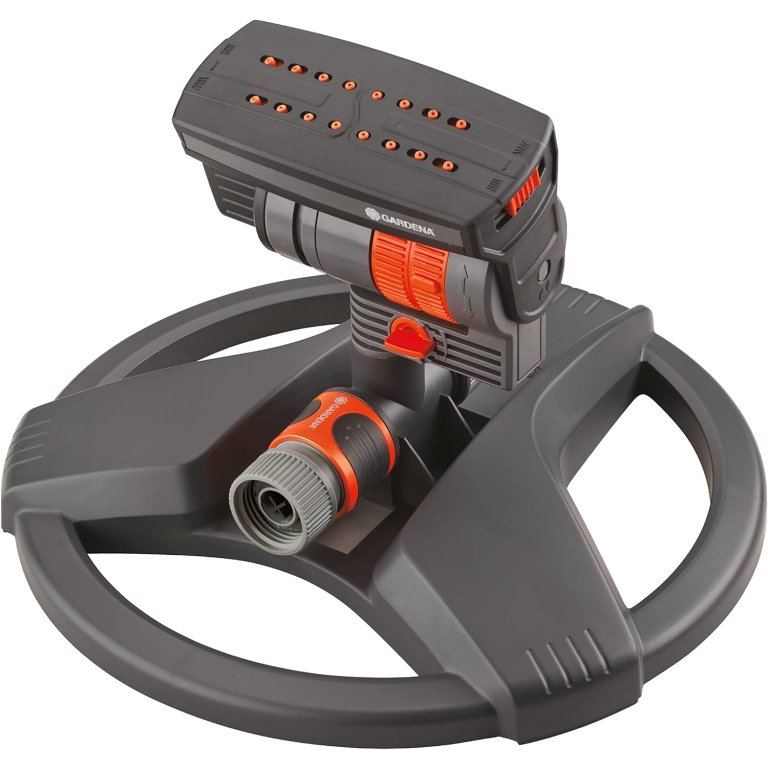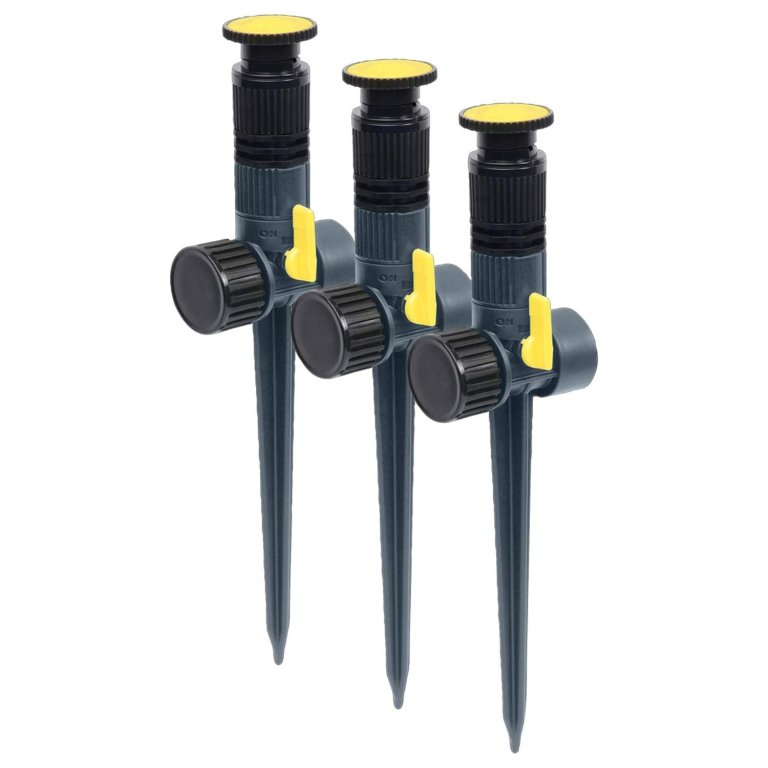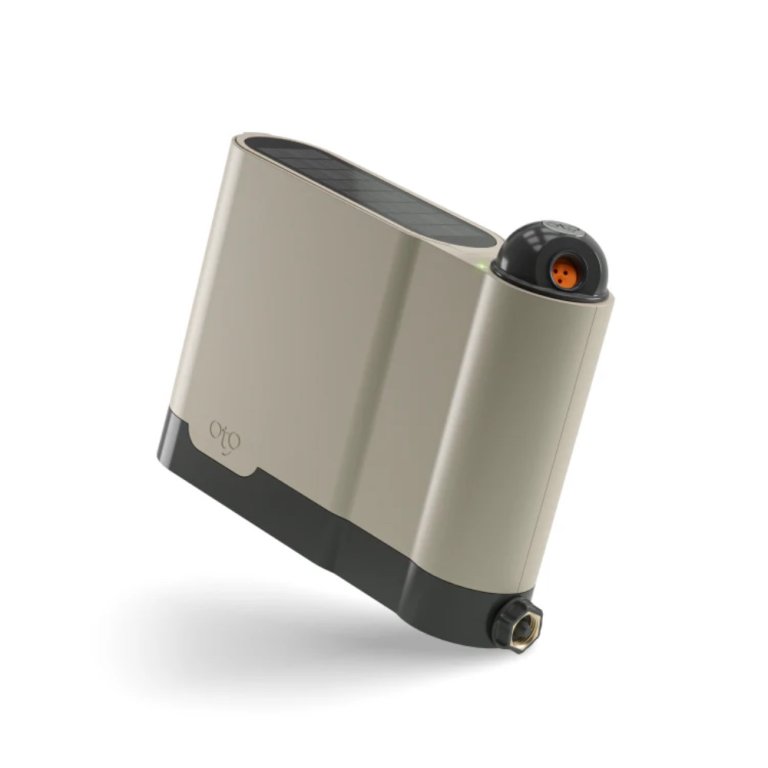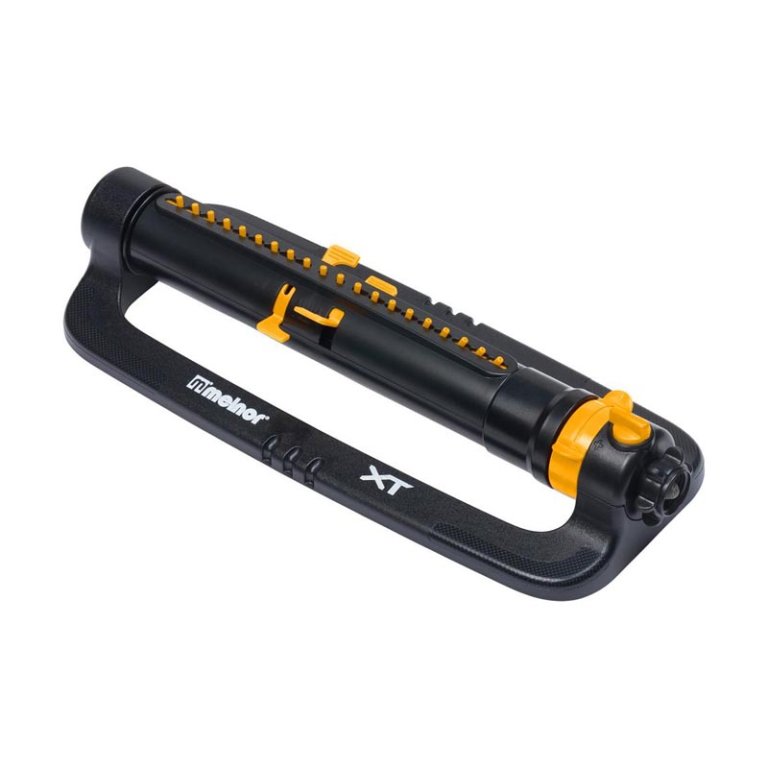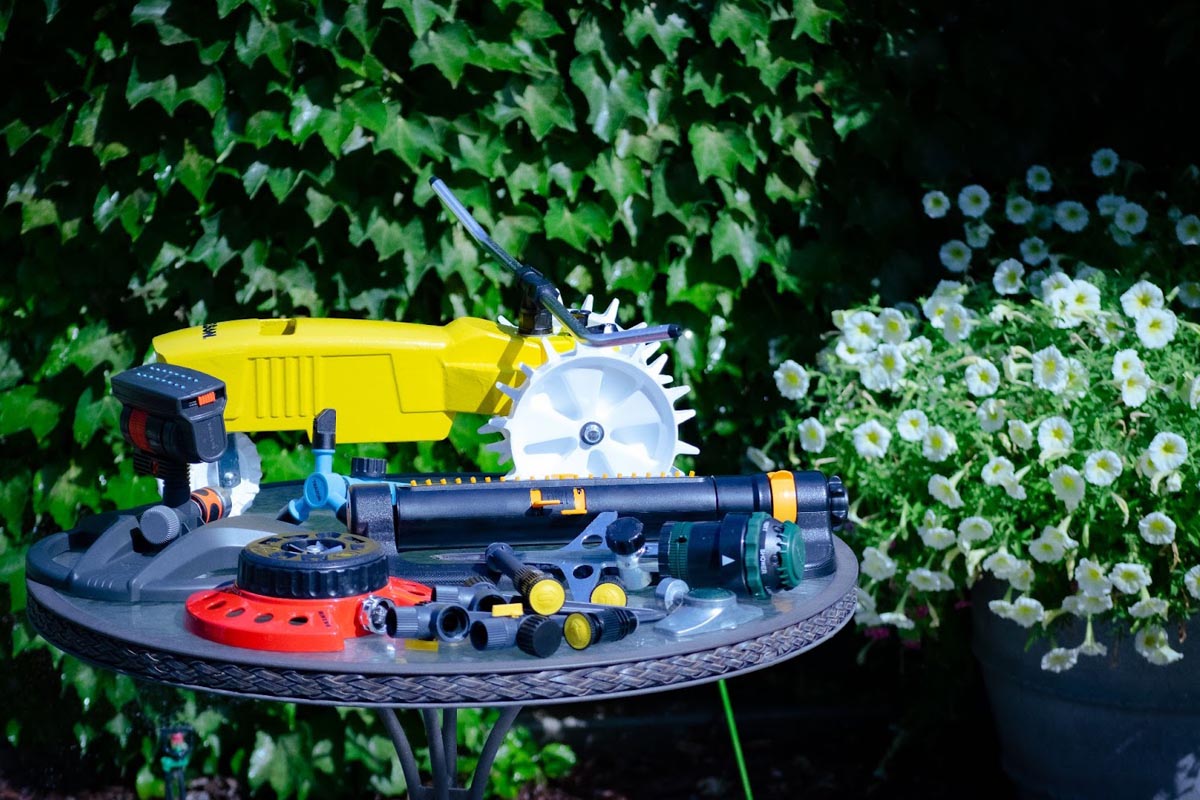
We may earn revenue from the products available on this page and participate in affiliate programs. Learn More ›
One of the keys to a healthy lawn and garden is having a reliable lawn sprinkler that effectively waters all the various spots in the landscape. We tested some of today’s top models to see which ones live up to their reputations. Some sprinklers require pulling a hose across the lawn to reach all the little corners and nooks, while others can be programmed to move around the yard, watering the grass while you tend to other matters. For stationary convenience, an underground sprinkler system with a sprinkler pump can run on a timer, and it will water all reaches of the yard.
We tested a variety of water sprinklers for lawns, and the Dramm 9-Pattern Turret Sprinkler came out on top thanks to its heavy base and nine spray patterns that fit different lawn and garden sizes or shapes. It wasn’t the only good option, though. Keep reading to better understand how the best lawn sprinklers can help meet the watering needs of your yard and to find out how each of the following models performed in our hands-on testing.
- BEST OVERALL: Dramm 9-Pattern Turret Sprinkler
Jump to Review - BEST BANG FOR THE BUCK: Gilmour 60-Spot Circle Sprinkler
Jump to Review - BEST OSCILLATING: Eden 4,973 sq. ft. Turbo Oscillating Sprinkler
Jump to Review - BEST FOR SMALL LAWNS: Gardena ZoomMaxx Oscillating Sprinkler
Jump to Review - BEST FOR GARDEN BEDS: Melnor 65083-AMZ Multi-Adjustable Sprinkler
Jump to Review - BEST SMART SPRINKLER: OtO Lawn Sprinkler
Jump to Review - ALSO CONSIDER: Melnor XT Oscillating Sprinkler With Flow Control
Jump to Review
| Type | Material | Coverage | |
| Dramm 9-Pattern Turret Sprinkler | Stationary turret | Metal | Up to 575 square feet, depending on pattern used |
| Gilmour 60-Spot Circle Sprinkler | Stationary | Metal | 30-foot diameter circle |
| Eden 4,973 sq. ft. Turbo Oscillating Sprinkler | Oscillating | Metal and plastic | Up to 4,973 square feet |
| Gardena ZoomMaxx Oscillating Sprinkler | Oscillating | Metal, plastic, and rubber | Up to 2,300 square feet |
| Melnor 65083-AMZ Multi-Adjustable Sprinkler | Fixed spike | Plastic | Up to 30 feet diameter per spike |
| OtO Lawn Sprinkler | Impact, smart | Plastic | Up to 30 feet diameter; 2,800 square feet total |
| Melnor XT Oscillating Sprinkler With Flow Control | Oscillating | Plastic | Up to 4,500 square feet |
Our Top Picks
Yards and budgets vary, so no single above-ground sprinkler system will be suitable for every yard. Still, we were impressed enough by the following sprinklers and their performance to include them in this guide. We looked at the overall quality of the sprinkler and the potential durability of any moving parts. Part of our testing involved assessing how well each sprinkler lived up to the manufacturer’s description. After testing, the following sprinklers came out on top, and all are well suited to various watering tasks.
Best Overall
Dramm 9-Pattern Turret Sprinkler
What We Like
- Heavy-duty metal base is sturdy and prevents sprinkler from tipping over
- Quality enamel coating provides lasting protection from wear and the elements
- 9 different water patterns can suit a wide variety of garden shapes and sizes
What We Don’t Like
- Manual shutoff at sprinkler is less than ideal
- Lacks full range compared to other options; may not be ideal for large yards
Product Specs
- Type: Stationary turret
- Material: Metal
- Coverage: Up to 575 square feet, depending on pattern used
Our Ratings: Ease of Use 4.5/5; Coverage 4.3/5; Durability 4/5; Value 5/5
This Bob Vila Approved product carries our brand’s highest level of recommendation.
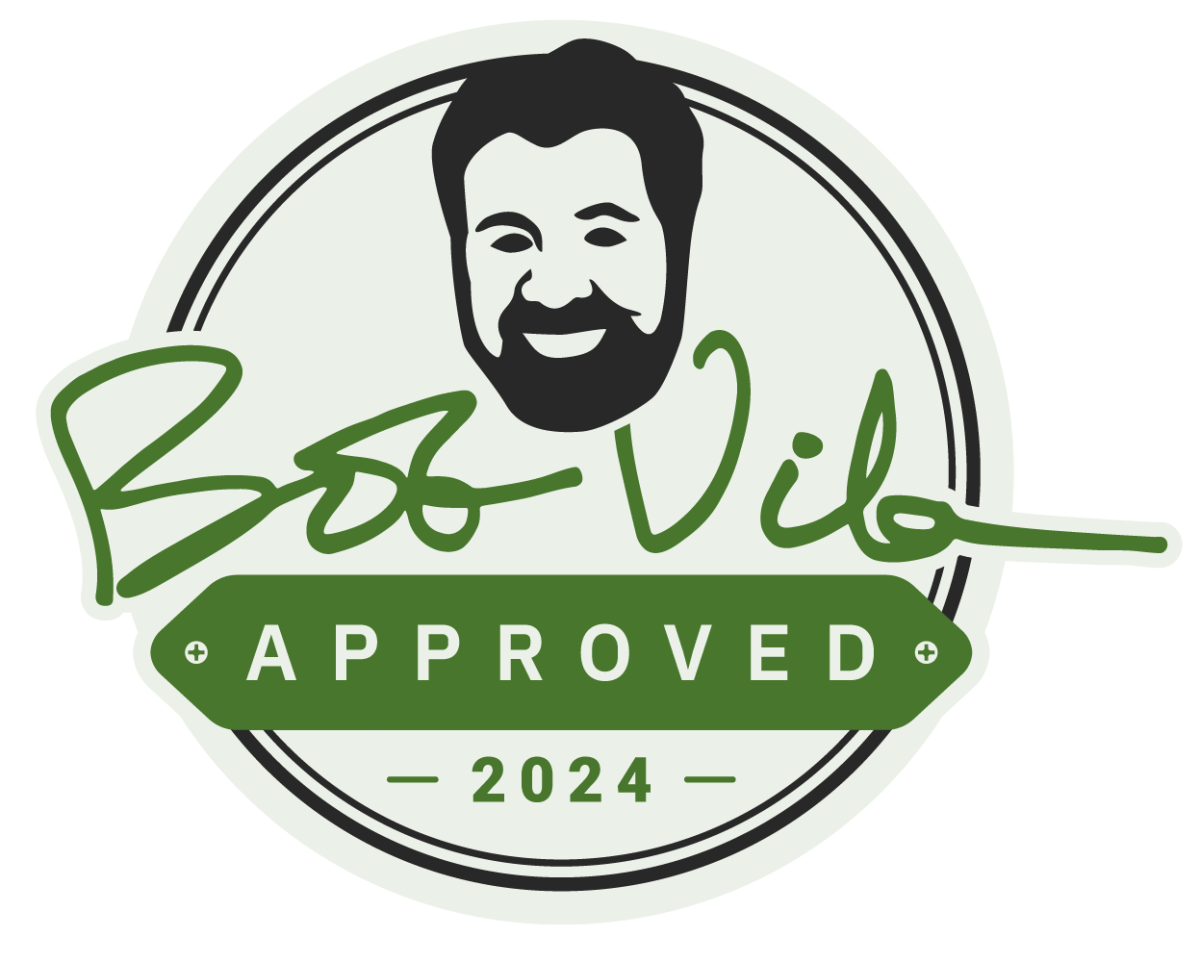
Bob Vila Approved recognizes the household and DIY products that impressed us most in our real-world testing and that exemplify core values of the Bob Vila brand, including craftsmanship, innovation, and value for the dollar. Winners of this designation come recommended by our professional review team and are personally approved by Bob Vila.
With the flexibility of delivering a narrow strip of water or a triangular spray, among other patterns, the Dramm sprinkler delivers just the right amount of water at the turn of a dial. It comes in several cheerful colors. We chose bright cherry red, and the first thing we noticed was that the paint was more like a quality enamel than a thin coating.
The Dramm sprinkler features a heavy-duty metal base that weighs 14.4 ounces, so it didn’t move—as flimsy sprinklers are prone to do—when we turned on the water pressure. It sat perfectly flat and did not shift. The sprinkler comes with an adjustable dial head that can be rotated between the nine different spray patterns. Users can water long, narrow areas; circular spots; or virtually any other spot in the yard or garden without inadvertently watering a neighbor’s yard.
We selected watering patterns with just a quick rotation of the black ring in the sprinkler’s center. Like many sprinklers, the width and distance were adjustable by lowering or raising the water pressure at the spigot. The spray patterns are accurately depicted on the dial’s face, and each one offers a uniform water spray.
Get the Dramm lawn sprinkler at Amazon or Blain’s Farm & Fleet.
Best Bang for the Buck
Gilmour 60-Spot Circle Sprinkler
What We Like
- Sizing is ideal for small nooks, flower beds, or gardens
- Metal construction is durable and can stand up to frequent use
- Affordable; a fraction of the price of other sprinkler options
- Sprays in a circular pattern and works well in low water-pressure areas
What We Don’t Like
- Smaller coverage is not suitable for large yards and gardens
- Can only be adjusted by changing the water flow at the spigot
Product Specs
- Type: Stationary
- Material: Metal
- Coverage: 30-foot diameter circle
Our Ratings: Ease of Use 5/5; Coverage 3.5/5; Durability 4.5/5; Value 4.8/5
At first, we almost didn’t see this little water sprinkler in the bottom of the shipping box—it’s just 3 inches long by 4.5 inches wide and stands less than 1 inch tall. It’s made to last, however, with its long-wearing metal construction. The body is molded from metal, and a durable metal spray insert is firmly attached to the top. This Gilmour sprinkler isn’t suitable for watering large yards, but it’s just the ticket for watering small nooks and spots that other sprinklers miss.
The sprinkler head sprays in a circular pattern that adjusts only by increasing or decreasing the water pressure at the spigot. The spray pattern is almost a perfect circle, and at maximum water pressure, it emitted a circle larger than advertised—nearly 45 feet in diameter. The high water pressure caused the sprinkler to list slightly to one side, so we would recommend using lower pressure to avoid this issue, or inserting a nail into the small hole at the top to help it remain flat if watering with high water pressure. We opted to use relatively low water pressure instead.
This little gem produces a uniform spray and is best suited to watering small areas in landscaped beds, rock gardens, and anywhere else a bigger sprinkler would be overkill.
Get the Gilmour lawn sprinkler at Amazon, Ace Hardware, or MSC Direct.
Best Oscillating
Eden 4,973 sq. ft. Turbo Oscillating Sprinkler
What We Like
- Can adjust oscillating range, water flow, and width of spray
- Heavy-duty metal base prevents sprinkler from tipping from high water pressure
- Features 20 nozzles and a turbo drive motor for even coverage
What We Don’t Like
- Might not meet listed coverage area without adequate water pressure
Product Specs
- Type: Oscillating
- Material: Metal and plastic
- Coverage: Up to 4,973 square feet
Our Ratings: Ease of Use 4/5; Coverage 4.8/5; Durability 5/5; Value 5/5
The Eden oscillating lawn sprinkler set can reach up to 4,973 square feet of lawn or garden. Since it has an adjustable range, width, and oscillating pattern, it’s a nice choice for yards of all sizes. The sprinkler features a heavy-duty metal base to prevent tipping and a sealed turbo-drive motor. It also comes with a built-in cleaning tool for clearing the nozzles.
Hooking up this lawn water sprinkler was as easy as attaching it to a lightweight garden hose. It also came with a quick-connection starter kit that includes a twist-and-lock mechanism to prevent accidental hose disconnection. After hooking up the hose, we turned it on and watered our yard on its maximum setting. Even with full water pressure, the metal base never tipped or twisted. We then used the push buttons on each side to narrow the spray’s width. These push buttons allowed us to go from using 20 jet nozzles to only 14.
The sprinkler also has sliding tabs to adjust the oscillating pattern and a water flow control knob for changing the range. We appreciated that this sprinkler had enough versatility to water our large lawn and small flower beds without wasteful overspray.
Get the Eden lawn sprinkler at Amazon.
Best for Small Lawns
Gardena ZoomMaxx Oscillating Sprinkler
What We Like
- Solid construction; stays firmly in place during use
- Can adjust the range, spray pattern, and water flow to suit different needs
- Flexible spray dimensions; great for watering narrow spaces without overspray
What We Don’t Like
- Adjustment nozzle can be stiff
- Knobs limit the sprinkler’s reach; not ideal for large lawns
Product Specs
- Type: Oscillating
- Material: Metal, plastic, and rubber
- Coverage: Up to 2,300 square feet
Our Ratings: Ease of Use 4/5; Coverage 4.5/5; Durability 4/5; Value 4/5
The first thing we noticed about the Gardena ZoomMaxx was how solid it was, so it stayed firmly put when in use. This is a great little compact sprinkler that can be adjusted to water various sizes of square and rectangular areas, covering a small space of about 8-foot square up to an area nearly 50 feet long by 20 feet wide. We were able to adjust the dimensions of the spray to water a narrow strip in our side yard and then readjust it to water a broader expanse of lawn.
The ZoomMaxx features 16 rubber nozzles on an oscillating head that moves back and forth with the pressure of the water. In addition, the sprinkler features a removable washable filter for keeping debris out of the moving sprinkler parts. We were impressed by the quality of the materials on the Gardena—it seems to be built to stand the test of time.
Get the Gardena lawn sprinkler at Amazon.
Best for Garden Beds
Melnor 65083-AMZ Multi-Adjustable Sprinkler
What We Like
- Each sprinkler features a 360-degree circular pattern, offering great coverage
- Spikes push easily into the ground for fast installation
- Can connect multiple spike sets to suit any yard size
What We Don’t Like
- Lightweight plastic construction is less durable than metal options
Product Specs
- Type: Fixed spike
- Material: Plastic
- Coverage: Up to 30 feet diameter per spike
Our Ratings: Ease of Use 4/5; Coverage 4.5/5; Durability 4/5; Value 5/5
It never fails; the direct-post sprayers that work so well for watering garden plants and flowers in spring are soon too short to spray over the growing plants to water the ones behind. These multi-adjustable sprinklers from Melnor offer a workable solution. Along with three spike sprinklers, we received three 5-inch risers to elevate the sprinklers when needed.
Each sprinkler comes with an adjustable head that allows the user to select anywhere from a small stream of water to a 360-degree circular pattern. In addition, each sprinkler features both a male and a female hose attachment end so all three can be connected via hoses. We found the plastic spikes to be well built and solid—they pushed easily into the ground, and we could adjust the spray on all three to where it watered our plants perfectly. Those with large or complex garden spots could save a lot of watering time by connecting two or more of these spike sets, eliminating the need to move a sprinkler around constantly.
Get the Melnor spike lawn sprinkler at The Home Depot.
Best Smart Sprinkler
OtO Lawn Sprinkler
What We Like
- Users can set custom zones for precise watering of lawns, flower beds, and gardens
- Monitors the local weather and skips watering on rainy days
- Compatible with OtO’s line of lawn solutions, including fertilizer, odor eliminator, and insect repellent
- Features a solar panel to keep it powered; also includes a charger for manual charging
What We Don’t Like
- Requires a reliable 2.45 gigahertz (GHz) internet connection and minimum water pressure of 50 PSI
- Expensive compared to other garden sprinklers; may be cost prohibitive for large yards
Product Specs
- Type: Impact, smart
- Material: Plastic
- Coverage: Up to 30 feet diameter; 2,800 square feet total
Our Ratings: Ease of Use 5/5; Coverage 5/5; Durability 4/5; Value 4.3/5
The OtO lawn sprinkler is a smart sprinkler with a 30-foot 360-degree reach that can water up to 2,800 square feet. It connects to Wi-Fi and allows users to customize the areas they’d like watered through its companion app. It also monitors the weather and skips watering on rainy days. This smart sprinkler is compatible with OtO’s line of lawn treatments that typically require a spreader, such as insect repellent, fertilizer, and odor eliminator. OtO says that all of the lawn treatments are pet-, people-, and planet-safe.
When we first received the OtO lawn watering sprinkler, we were worried that getting it set up would be difficult. To our surprise, after charging the unit overnight, it only took about 15 minutes to connect it to Wi-Fi and program our first “zone.” We then set OtO to water our lawn at 6 a.m. every day. The app monitored the weather and let us know when it would skip watering on rainy days, which we could override manually if desired.
The app also allowed us to choose weekly watering limits, which ranged from 0.5 inch to 2 inches. We chose the “normal” limit, which is 1.25 inches of watering per week. Overall, we were impressed by OtO’s features. It’s a good choice for those who want a set-it-and-forget-it type of sprinkler. However, it is expensive and might not be worth the money for those with a large lawn or who don’t anticipate needing a sprinkler in the long term.
Read our full review: OtO Lawn Sprinkler
Get the OtO lawn sprinkler at Oto.
Also Consider
Melnor XT Oscillating Sprinkler With Flow Control
What We Like
- Broad base with solid design that resists tipping or wobbling
- Adjustable spray length can suit a range of garden shapes and sizes
- Features a nozzle-cleaning tool; no more blocked sprinkler holes
What We Don’t Like
- Spray width is not great for narrow lawns or gardens
- Hose filter needs to be cleaned regularly to prevent blockages
Product Specs
- Type: Oscillating
- Material: Plastic
- Coverage: Up to 4,500 square feet
Our Ratings: Ease of Use 4.5/5; Coverage 4.3/5; Durability 4/5; Value 4.5/5
Oscillating sprinklers sometimes work themselves sideways while watering, so we were pleasantly surprised to find that the Melnor XT sprinkler stayed exactly where we placed it. Its broad base and solid design kept it firmly positioned, even when we turned the water up to the highest pressure. Using the two sets of levers in the center of the sprinkler, we could adjust the width of the spray pattern from about 10 to 20 feet wide. By twisting the yellow ring on the end of the Turbo, we could change the length of the spray pattern from about 20 to nearly 50 feet.
The sprinkler’s rectangular oscillating head features 20 precision nozzles for uniform water distribution, and the unit comes with a nozzle-cleaning tool to help remove any blockages that might occur. This Melnor model also features a metal filter washer in its hose fitting for trapping debris. The sprinkler is made from heavy-duty plastic and weighs 1.1 pounds. Perhaps our favorite feature on this one is the independent twisting hose connector—there’s no need to twist the hose or rotate the sprinkler to connect the two. Just twist the plastic connector to quickly and securely attach the sprinkler.
Read our full review: Melnor XT Oscillating Sprinkler With Flow Control
Get the Melnor XT lawn sprinkler at Amazon.
Jump to Our Top Picks
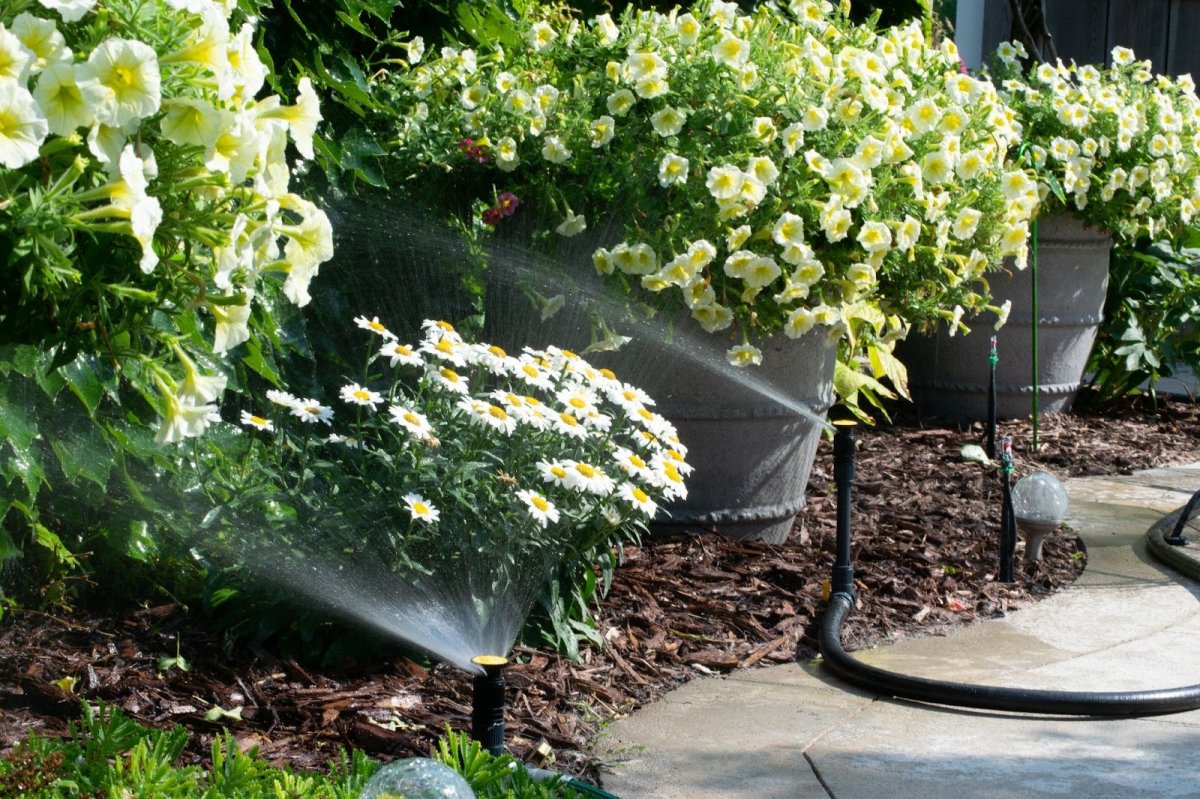
How We Tested the Best Lawn Sprinklers
To pinpoint which sprinklers were best for certain tasks, such as watering large areas of grass or keeping a flower bed well irrigated, we tested several sprinkler types. We individually tested each sprinkler by assembling parts (if necessary) and then attaching each to a garden hose. Next, we observed how each sprinkler operated and whether it met the manufacturer’s watering claims. For adjustable sprinklers, we selected and observed each of the different watering patterns, taking note of the size of the watering patterns as well as the distribution of water droplets.
The maximum water pressure at our outdoor spigot runs an average of 60 pounds per square inch (PSI), but we didn’t test all the sprinklers at maximum pressure. We adjusted the pressure to suit the individual sprinkler, meaning we used a lower water pressure to water small areas of the flower garden and full pressure when testing lawn sprinklers. Unless a spigot has unusually low water pressure, the sprinklers in this lineup should perform well in most residential settings.
| Testing Stats | |
| Products tested | 10 |
| Hours spent testing | 12-plus |
| Tests performed | 3 |
| Average price | $17 to $35 |
| Ease of Use | Coverage | Durability | Value | |
| Dramm 9-Pattern Turret Sprinkler | 4.5/5 | 4.3/5 | 4/5 | 5/5 |
| Gilmour 60-Spot Circle Sprinkler | 5/5 | 3.5/5 | 4.5/5 | 4.8/5 |
| Eden 4,973 sq. ft. Turbo Oscillating Sprinkler | 4/5 | 4.8/5 | 5/5 | 5/5 |
| Gardena ZoomMaxx Oscillating Sprinkler | 4/5 | 4.5/5 | 4/5 | 4/5 |
| Melnor 65083-AMZ Multi-Adjustable Sprinkler | 4/5 | 4.5/5 | 4/5 | 5/5 |
| OtO Lawn Sprinkler | 5/5 | 5/5 | 4/5 | 4.3/5 |
| Melnor XT Oscillating Sprinkler With Flow Control | 4.5/5 | 4.3/5 | 4/5 | 4.5/5 |
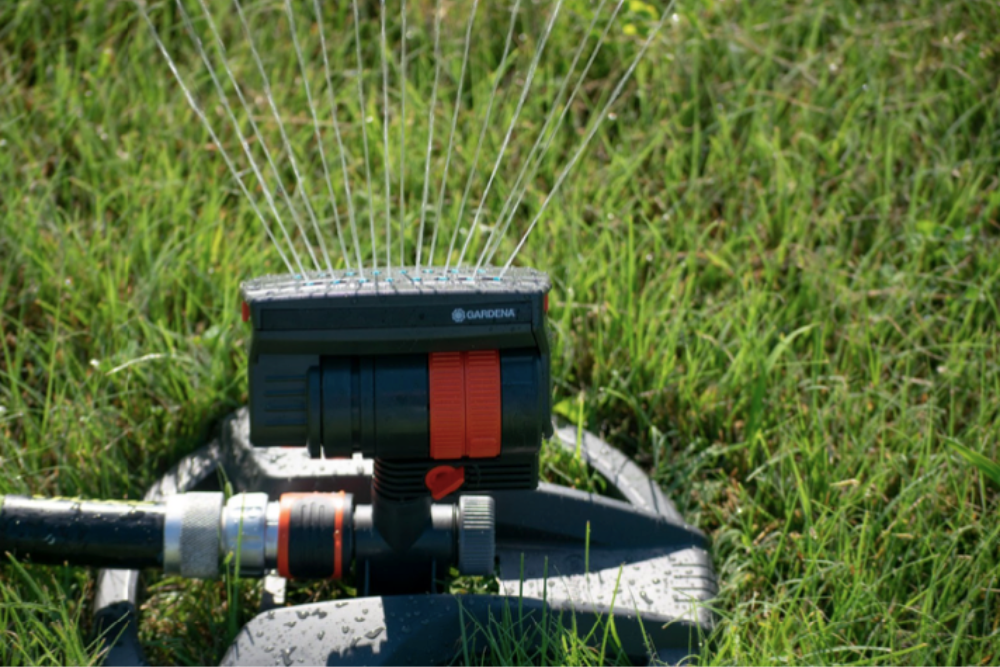
What to Consider When Choosing a Lawn Sprinkler
Lawn sprinklers are among the most helpful lawn and garden products. They disperse water in various spray patterns, powered by the pressure of the water in the hose. They can be made from a variety of materials, and some have moving parts, while others don’t. Individual watering needs are among the top considerations when looking for the best lawn sprinkling systems for a lawn or garden. Another consideration is sprinkler system costs, which vary greatly by type.
Type
Lawn sprinklers fall into six primary categories, ranging from immobile to roaming. When choosing a sprinkler, consider the local climate and whether conserving water is a priority. Watering needs for a newly seeded lawn differ from the watering needs of a vegetable garden or an established lawn.
- Fixed or stationary sprinklers vary in design and reach, but each connects to a garden hose and sprays water in the same pattern over the same area until moved. Typically only able to cover a radius of 5 to 15 feet at a time, this type of sprinkler is best suited for small yards and compact gardens.
- Oscillating sprinklers feature a row of multiple openings to disperse water in a semicircular spray. The lawn sprinkler heads and the resulting water fan then move from side to side, so the irrigation covers a larger area than most stationary models.
- Rotating or rotary and impact sprinklers spin 360 degrees as they release water. The former typically has two or more arms that spin, while the latter (sometimes known as an impulse or pulsating sprinkler) spews water from a single jet, clicking as it turns its full rotation. As a result, an impact sprinkler often boasts the farthest range of water distribution.
- Sprinkler hoses are essentially rubber hoses with small perforations lined along the top that emit a fine, controlled spray. The length and flexibility of these models work well for watering long, narrow, and even irregularly curved patches of grass since they stretch out over the ground like a vine.
- Traveling sprinklers roll through the yard (garden hose in tow) in a programmed pattern. Also called “lawn tractors,” they move like a miniature lawn mower while watering the grass.
- Inground sprinkler systems take the guesswork out of watering the yard by operating on a set schedule. While there’s more effort up front to map out the watering system, dig trenches for water lines, and connect a new ground sprinkler system to the water main, the strategically placed sprinkler heads can be programmed to emerge from the ground and water the lawn at preset times. Many of today’s sprinkler system controllers are smart-home capable, allowing the user to program the settings via a smart device. Choosing the right sprinkler pump for an inground system is based on the number of zones and available water pressure.
Material
Plastic and metal are the two most common types of materials found in lawn sprinklers, but some models include rubber and silicone parts. The quality of the materials varies, and some types of plastic are durable, heavy, and fade-resistant. Less expensive models may be thin, fade quickly, and become brittle in a season or two.
Metal sprinklers are typically a bit more durable than plastic, but the quality of the metal also varies. Rustproof chrome and stainless steel are among the best metal materials for sprinklers. Many have moving parts, and those with sealed ball-bearing connectors will be among the most durable.
Coverage Area
Many of today’s best lawn sprinklers include the ability to adjust the pattern and distance of the water spray, often by sliding a lever on the top or the side of the sprinkler. This allows the user to select various watering patterns and sizes, including circular-, rectangular-, triangular-, and fan-shape patterns.
Ultimately, the amount of water pressure in the hose will determine the maximum distance of the water pattern. For example, a distance-type impact sprinkler may be advertised as capable of shooting a stream up to 30 yards, but if the water pressure in the hose is low, the coverage area will be less. Most residential water systems feature pressure between 30 and 60 PSI, and most lawn sprinkler irrigation systems work best with a minimum of 30 PSI of water pressure. However, a few require higher PSI to reach their advertised coverage area.
Water Conservation
Watering the lawn consumes a good deal of water. If the hose is 0.5 inch in diameter and the water pressure is 60 PSI, the average usage will be around 630 gallons during an hour of watering. As the garden hose diameter increases, so does water usage. A 0.625-inch hose delivers approximately 1,020 gallons at the same water pressure, and a 0.75-inch hose will deliver 1,860 gallons.
Some lawn sprinkler systems come equipped with features to help control water usage and, in the case of smart sprinklers, estimate how long to water the lawn. An inground sprinkler system typically has automatic timers through which the user can schedule exact watering plans (when, where, and how much water) in advance. For above-ground sprinklers, comparable features to look for include auto shutoffs and flow timers that monitor and limit the amount of water used. The best hose timers also offer an affordable solution for controlling the amount of water used.
FAQs
Yard sprinkler systems vary widely in quality, price, and the type of water pattern they disperse. Choosing the best lawn sprinkler requires considering the lawn or garden’s individual water needs. For some yards, more than one sprinkler may be necessary. For those just starting the sprinkler shopping process, here are answers to some popular questions.
An efficient garden sprinkler should reach all areas of a lawn or garden without being blocked by tall plants. This may mean using a small rotating sprinkler and moving it from location to location as needed, or using a set of connecting sprinklers that can be positioned independently to cover all the plants at once.
An oscillating sprinkler will cover a wide lawn expanse. A traveling, or tractor-type, sprinkler can be positioned at one end of a large lawn, and it will eventually work its way to the other end, watering a large swath along the way.
Sprinklers dispense water at different rates, so rather than a set number of minutes, the general rule is to water enough so that the lawn receives 1 inch of water per week.
It’s better to water your lawn longer than more often. The average lawn needs 1 inch of water per week, which you can divide into two 30-minute sessions.
Meet the Testers
Glenda Taylor is a product tester and writer specializing in the construction, remodeling, and real estate industries. She tests a wide range of power tools as well as other home improvement, household, and lawn-and-garden products.
Katie Barton has over 10 years of experience in product writing, has tested dozens of cleaning products, and has authored hundreds of articles for major media outlets. She takes an unbiased approach to product testing, using each product multiple times or for several days/weeks to determine efficacy. Her goal is to help readers decide which products are worth their hard-earned money and which fall flat.
